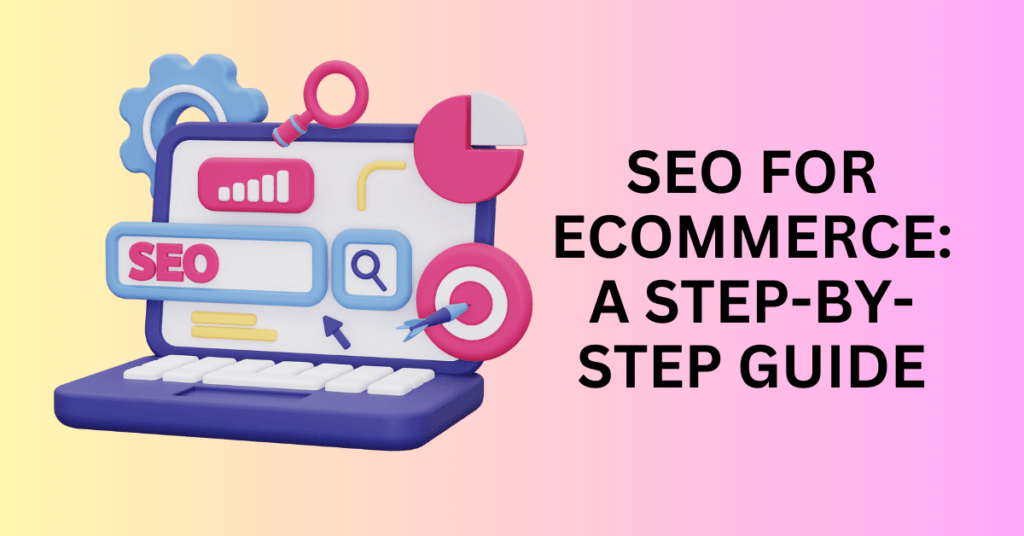For eCommerce website owners, getting traffic for your eCommerce store is the most important for your business success. There are both organic and paid traffic that you can generate for your eCommerce store. However, for a long-term traffic strategy, SEO for eCommerce is the way to bring in organic traffic.
While SEO for eCommerce is important, it is not that easy to implement without a proper strategy. Moreover, it takes time and effort for your eCommerce store to rank top of search engine results.
Today, we will share everything you need about SEO for eCommerce and how you can implement that for your eCommerce store.
Start Your eCommerce Store with Shopify
Understanding SEO for eCommerce

Search Engine Optimization (SEO) for eCommerce is a vital strategy that involves enhancing the visibility and ranking of an online store’s website in search engine results. The primary goal is to attract organic, high-quality traffic that is more likely to convert into customers.
SEO for eCommerce revolves around optimizing product pages, categories, and the overall website structure to make it more accessible and appealing to both search engines and users. This involves keyword research to identify relevant search terms potential customers might use, and integrating them naturally into the website’s content, meta descriptions, titles, and headings.
Additionally, optimizing images, improving website speed, ensuring mobile-friendliness, and obtaining high-quality backlinks from reputable sources are key components of a successful eCommerce SEO strategy.
One crucial aspect of eCommerce SEO is on-page optimization. This involves optimizing individual product pages to make them search engine-friendly and user-centric. Furthermore, you will need to create compelling and unique product descriptions, optimise images with descriptive alt text, and incorporate relevant keywords naturally.
Off-page optimization, on the other hand, focuses on building a strong online presence through link building, social media marketing, and influencer collaborations to increase the website’s authority and credibility.
After implementing the SEO strategy, you will then need to monitor and analyze website performance using tools like Google Analytics and adjust strategies based on the data. This is an ongoing process to ensure that the eCommerce website remains competitive and continues to attract organic traffic. This will then ultimately lead to increased sales and revenue.
Start Your eCommerce Store with Shopify
Benefits of SEO for eCommerce

Following SEO best practices can be useful for your online store in many ways.
1. Organic Traffic – SEO for eCommerce
Search Engine Optimization (SEO) enhances organic traffic for eCommerce by strategically incorporating relevant keywords throughout the website. This can then be conducted through keyword research and seamlessly integrating these keywords into the content, meta tags, headings, and URLs to increase visibility in search results related to the products or services offered.
Additionally, optimizing content for quality and relevance ensures visitors find valuable information, enticing them to stay longer on the site and explore further. For businesses with physical locations or specific target areas, local SEO strategies optimize for location-based keywords and local listings, attracting targeted local organic traffic.
2. Lead Generation – SEO for eCommerce
SEO is pivotal in lead generation for eCommerce websites. Optimizing landing pages is a key strategy. It can also ensure the feature of compelling content, clear calls-to-action (CTAs), and effective lead capture forms, prompting visitors to take desired actions like signing up, subscribing, or downloading resources.
A seamless, user-friendly experience further enhances lead generation by streamlining navigation, minimizing page load times, and ensuring mobile responsiveness. Continuous A/B testing and iteration of various website elements based on user behaviour and feedback help in refining strategies and maximizing lead conversion rates.
3. Brand Awareness – SEO for eCommerce
Efficient SEO efforts significantly contribute to brand awareness. Achieving higher rankings in search engine results instils credibility and trust among users. This will then elevate brand awareness and position the eCommerce business as an authority in its niche.
You can integrate SEO with a strong social media presence to amplify brand exposure. This is because users often engage with brands across multiple platforms, leading to increased brand recognition and a broader audience reach.
Moreover, creating and promoting valuable, shareable content aligned with the brand’s values and message aids in SEO and enhances brand visibility as it gets shared and distributed across the web.
4. Higher Click-Through Rate (CTR) – SEO for eCommerce
A well-executed SEO strategy positively impacts the click-through rate (CTR) of an eCommerce website. You can craft compelling meta titles and descriptions that accurately represent the content on the page. This will entice users to click through to the site, thus improving the CTR.
Besides, you can also implement rich snippets and schema markup to provide additional information in search results. This will include star ratings, reviews, or product prices, attracting attention and encouraging clicks.
Moreover, optimizing URLs to be clear, concise, and descriptive offers users a preview of the page’s content, motivating them to click and enhancing the overall CTR.
5. Improved User Experience – SEO for eCommerce
SEO plays a crucial role in enhancing user experience on eCommerce websites. Website speed optimization is paramount, involving actions like image optimization, efficient coding, and browser caching to reduce page loading times.
A mobile-friendly design ensures a seamless and enjoyable browsing experience for users accessing the site on smartphones and tablets, given the increasing use of mobile devices. Additionally, you can create intuitive navigation to organize your website’s structure logically. This will make it easy for users to find what they’re looking for. And this can contribute to overall satisfaction, encouraging them to explore further and potentially convert.
Start Your eCommerce Store with Shopify
A step-by-step guide to SEO for eCommerce strategy

A well-crafted SEO strategy can significantly enhance your website’s rankings, leading to increased brand awareness, higher traffic, and ultimately, more sales. In this comprehensive guide, we will outline a step-by-step approach to creating an effective eCommerce SEO strategy in 5 key steps.
Step 1: Conduct Thorough Keyword Research
Keyword research lays the foundation for a successful eCommerce SEO strategy. Understanding the search terms and phrases potential customers use when looking for products or services similar to yours is crucial.
Start by brainstorming a list of relevant keywords and then use keyword research tools such as Google Keyword Planner, SEMrush, or Moz’s Keyword Explorer to refine and expand this list.
Ensure you focus on long-tail keywords, which are longer and more specific phrases that potential customers are likely to use. In addition, long-tail keywords often have lower competition and higher conversion rates.
Keyword Relevance: Aligning with Your Business
Relevance is paramount. Your chosen keywords must align with your eCommerce business, products, and services. Think from the perspective of your target audience – what words would they use to find what you offer?
Your keywords should mirror these thoughts.
Search Volume: Gauging Demand
Search volume indicates the number of times a keyword is searched for within a specific period. Higher search volume suggests higher demand. However, striking a balance between relevance and search volume is essential.
Aim for keywords with a substantial search volume but ensure they are directly related to your eCommerce offerings.
Competition: The SEO Battlefield
Keyword competition measures how challenging it is to rank for a specific keyword. High competition means many businesses are vying for the top spot. You should also analyze your competitors’ strategies and opt for keywords with a moderate level of competition.
This will then give you a fair chance to rank and compete effectively.
Long-Tail Keywords: Precision Matters
Long-tail keywords are longer, more specific keyword phrases. While they may have a lower search volume, they often convert better as they reflect a more precise search intent.
Integrate a mix of long-tail keywords into your strategy to capture highly targeted traffic.
Seasonal Trends: Riding the Wave
Understanding seasonal trends is pivotal, especially for eCommerce. Some products or services might experience spikes in demand during specific seasons or events.
Align your keyword strategy to these trends to capitalize on increased search volume and potential conversions during these periods.
Cost Per Click (CPC): Value vs. Investment
CPC represents the cost advertisers are willing to pay for a click on their ads for a particular keyword. While this metric is more relevant for paid advertising, it provides insights into a keyword’s value. A higher CPC often indicates the keyword’s commercial intent.
This could translate into valuable traffic for your eCommerce site.
Step 2: Optimize On-Page Elements
On-page optimization involves optimizing various elements on your eCommerce website to enhance its visibility and relevance to search engines.
Here are key on-page elements to focus on:
a. Title Tags and Meta Descriptions
Craft unique, compelling title tags and meta descriptions for each product page. This will also include relevant keywords and ensure they accurately describe the content of the page, encouraging users to click through.
b. URL Structure
Optimize your URLs to be clean, descriptive and include relevant keywords. You should avoid long, complicated URLs that can confuse both users and search engines.
Ideally, your URL should be clean and memorable so people can just type it out and visit your website.
c. Header Tags (H1, H2, H3)
Use proper header tags to structure your content, making it easier for search engines to understand the hierarchy and relevance of the content.
At the same time, you need to incorporate keywords naturally into these headers. Having different headers helps your audiences to scan through your content easily.
d. Image Optimization
Optimize images by using descriptive file names and alt text that include relevant keywords. This helps search engines understand the content of the images and can improve your website’s visibility in image searches.
e. Content Optimization
Create high-quality, informative, and engaging content for your product pages and blog posts. You will need to also integrate relevant keywords naturally within the content while ensuring readability and user engagement. Also, aim for a balance between keyword optimization and providing valuable information to the user.
Step 3: Focus on Technical SEO
Technical SEO involves optimizing the technical aspects of your eCommerce website to enhance its performance and make it more search engine-friendly.
a. Mobile Optimization
Ensure your website is optimized for mobile devices as a significant portion of online traffic comes from mobile users. Responsive design and fast-loading pages are essential for a positive user experience on mobile.
b. Site Speed
Optimize your website for speed to enhance user experience and improve search engine rankings. You should then compress images, minimize code, and leverage browser caching to reduce loading times.
c. Schema Markup
Implement schema markup to provide search engines with additional information about your products. This can enhance the appearance of your listings in search results, potentially increasing click-through rates.
d. SSL Security
Ensure your website has a valid SSL certificate, indicating a secure connection. Google considers SSL as a ranking factor and users trust secure websites.
Step 4: Build High-Quality Backlinks
Backlinks are the backbone of a successful SEO strategy, particularly for eCommerce websites. These links from other websites to yours can significantly impact your search engine rankings and, consequently, the organic traffic your site receives.
However, not all backlinks are created equal. Quality is key, and in this guide, we’ll walk you through the steps to acquire high-quality backlinks for your eCommerce site effectively.
Backlinks, also known as inbound or incoming links, are hyperlinks from one webpage to another. Search engines like Google view these links as a vote of confidence, indicating that the linked-to content is valuable.
The more high-quality backlinks your site has, the more credible and authoritative it appears to search engines.
1. Create Exceptional Content
Creating top-notch content is the foundation of any successful backlink strategy. Your content should also be informative, engaging, and valuable to your target audience. It could then include well-researched blog posts, informative product guides, in-depth case studies, or visually appealing infographics.
2. Identify Linkable Assets
Identify specific pages or content on your eCommerce site that have the potential to attract backlinks. These could also be unique product pages, informative blog posts, insightful industry reports, or any content that stands out and provides value.
3. Competitor Analysis
Conduct thorough research on your competitors’ backlink profiles. Then, analyze the sources of their backlinks and identify opportunities that might be relevant for your site as well. Tools like Ahrefs, Moz, and SEMrush can be immensely helpful in this regard.
4. Building Relationships with Influencers and Bloggers
Connect with influencers and bloggers in your industry. Then, offer them your products for review or propose a collaboration on sponsored content. Guest posting on their platforms can also be an effective way to gain backlinks.
5. Leverage Guest Posting
Contribute high-quality guest posts to reputable blogs within your niche. Within these posts, you can then include a link back to your eCommerce site. Ensure that the blog you’re guest posting on has good domain authority and is relevant to your industry.
6. Broken Link Building
Identify broken or outdated links on other websites in your industry. You can then offer to replace these broken links with links to your relevant and high-quality content. Tools like Ahrefs and SEMrush can assist in finding these opportunities.
7. Engage in Industry Forums and Communities
Participate actively in forums and communities related to your eCommerce niche. Provide valuable insights and solutions to community members, and include a link to your content or website when relevant and helpful.
8. Collaborate with Industry Partners and Suppliers
Establish partnerships with industry suppliers, manufacturers, or complementary businesses. They may link to your site from their website, especially if you carry their products.
9. Optimize for Local SEO
Ensure your business is listed in local directories and optimize your Google My Business profile. Local backlinks from reputable local businesses or directories can significantly boost your local search rankings.
10. Utilize Social Media and Social Bookmarking Sites
Share your content on various social media platforms and relevant social bookmarking sites. While these links may not have a direct impact on SEO, they can drive traffic and generate social signals.
11. Create Infographics and Visual Content
Design visually appealing infographics or other types of visual content that people are likely to share. You can also include embed codes to make it easy for others to share and link back to your eCommerce site.
12. Monitor and Analyze Backlinks
Regularly monitor your backlink profile using SEO tools. Disavow any low-quality or spammy backlinks to maintain a clean and high-quality link profile.
13. Be Patient and Persistent
Building a strong portfolio of high-quality backlinks takes time and persistence. Stay committed to creating exceptional content and building relationships within your industry for long-term success.
Incorporating these strategies into your eCommerce marketing plan will help you attract high-quality backlinks, improving your site’s authority, search rankings, and ultimately, your business’s success. Finally, you should stay focused, produce exceptional content, and engage with your industry to build a network of valuable backlinks.
Step 5: Monitor, Analyze, and Adapt
The final step in a successful eCommerce SEO strategy is continuous monitoring and adaptation. You need to use analytics tools like Google Analytics and Google Search Console to track your website’s performance, including organic traffic, keyword rankings, and user behaviour.
a. Track Keyword Rankings
Regularly monitor your keyword rankings to assess the effectiveness of your SEO efforts. Identify keywords that are performing well and those that need improvement.
b. Analyze User Behavior
Understand how users interact with your website. Analyze metrics such as bounce rate, time on page, and conversion rates to identify areas for improvement.
c. Adapt Your Strategy
Based on the data and insights gathered, adapt your SEO strategy accordingly. This might involve tweaking keywords, optimizing content, or refining your backlinking approach.
Final thoughts: Complete Guide of SEO for eCommerce
SEO for eCommerce is very important for your business. You will get more organic traffic in the long run when your store is ranked for the highly searched keywords.
With a strong SEO strategy for your eCommerce business, you can lower your customer acquisition cost as you don’t pay for the traffic. A few important SEO strategy for eCommerce includes keyword research, content optimization, link building and analysis performance.
Start building your eCommerce store today and implement the SEO strategy to grow and scale your business.


